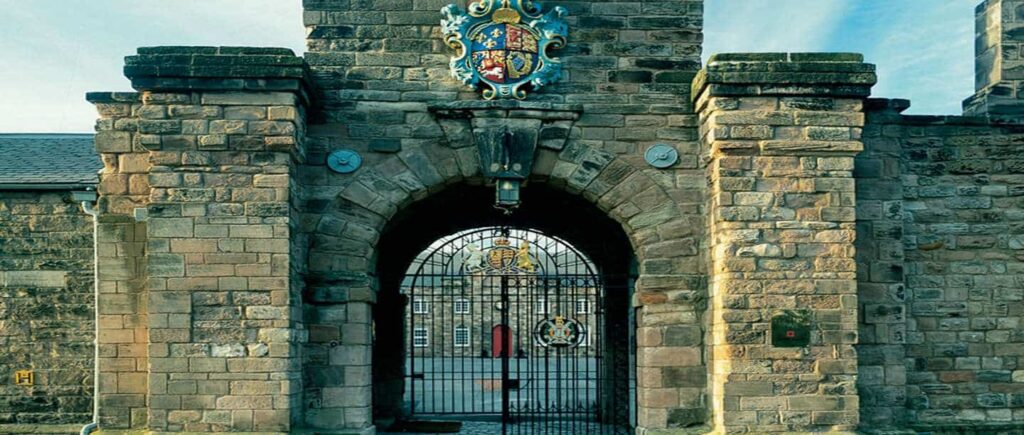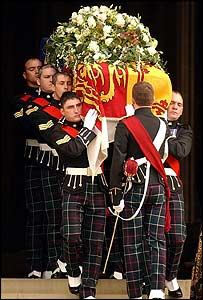
Lady Alice Christabel Montagu-Douglas-Scott, sister of the 8th Duke of Buccleuch, a former CO of the 4th Battalion, was born in London on Christmas Day 1901 at Montagu House on the site of the present Ministry of Defence. Lady Alice was the fifth of eight children of the Earl of Dalkeith – son and heir of the 6th Duke of Buccleuch and 8th of Queensberry – and his wife Margaret, a daughter of the 4th Earl of Bradford.
Lady Alice was always a child of the Borders and there could not have been a more appropriate appointment. The future Princess grew up at Eildon Hall, in the Borders and at Bowhill. Here Lady Alice indulged her passion for country sports, fishing and fox-hunting. Formal occasions were never her idea of fun. Lady Alice neither smoked nor drank, and far preferred the outdoor life to London entertainment.
In 1924, in her early twenties, Lady Alice first visited Africa and loved the life there. In 1929 on another extended holiday in Kenya with her Uncle and Aunt, Lady Alice developed her talent as a water colourist to such good effect that she was able to finance a second trip from the proceeds of a favourably reviewed London exhibition. On this second trip Lady Alice also visited India, and made a sortie into Afghanistan disguised as a boy.
Called home in 1935, as her father’s health was failing, Lady Alice married her long-term friend Prince Henry, third son of King George V. Sadly the Duke of Buccleuch, a close friend of King George V since childhood, died shortly after the engagement, and the marriage took place in private at Buckingham Palace. Princess Elizabeth, the future Queen and Princess Margaret Rose were bridesmaids and more than a million people lined the London streets to wave the couple off on their honeymoon. Prince Henry’s burning ambition had been to command the 10th Hussars, but with the Abdication, as Regent Apparent he had to abandon his military career for public duties. Likewise, Princess Alice had to adjust to being a member of the Royal Family. Initially, the Duke and Duchess of Gloucester lived in Aldershot but when the Duke left the army the couple received a grace and favour residence at York House, St James’s Palace and, in 1938, they purchased Barnwell Manor in Northamptonshire.
In 1937 the Duchess received the Freedom of Edinburgh and was appointed Colonel-in-Chief of the KOSB. The Regiment presented her with a jewelled regimental broach in a case made from cherry wood from the Buccleuch Estate.
The Second World War increased her duties. The Princess became President of the Hospital Supply Branch of the Red Cross to add to her role as Commandant of the St John’s Ambulance Association and Brigade, and in 1940, the Princess became Air Chief Commandant of the Women’s Auxiliary Air Force, of which she was promoted Air Marshal in 1968.
During the War Princess Alice made visits across the UK, and visited every corner of the kingdom, arriving in Belfast the morning after the first German air raid. Her eldest son, Prince William of Gloucester was born in 1941 and his brother Prince Richard in 1944. In 1944 the Duchess went with her husband and young family to Australia, where Prince Henry served as Governor-General for three years. The Duke and Duchess also carried out other prestigious foreign engagements. In 1957 in particular, when they represented the Queen at the declaration of Malaysian independence, the Duchess took pains to visit the King’s Own Scottish Borderers, deployed in the middle of the jungle, with a present of Scottish heather for each man.
Throughout her time as Colonel-in-Chief, the Princess attended many Regimental functions and visited the Regiment all over the world. The Princess was also Colonel-in-Chief of the Royal Hussars, the Royal Corps of Transport, the Royal NZ Army Service Corps, the Northamptonshire Regiment and Deputy Colonel-in-Chief of the Royal Anglian Regiment.
Catastrophe struck in 1965 when, driving back from Sir Winston Churchill’s funeral, the Duke and Duchess had a serious motor accident. The Duchess suffered a broken arm and facial cuts and the Duke, though superficially unharmed, never quite recovered from the trauma, and by 1968 successive strokes had reduced him to a helpless invalid. Three years later, Prince William was killed in 1972 while piloting his aircraft in an air race and the Duke died in 1974. In 1975, Princess Alice was the first woman to be appointed a Dame Grand Cross of the Order of the Bath and in 1981, the Princess published her memoirs.

In 1994 the Gloucesters moved from Barnwell to Kensington Palace, where she lived with the current Duke and Duchess of Gloucester. In 1988 at the age of 87, the Princess made, what would be her last formal visit to the 1st Battalion KOSB in West Berlin. In December 2001, Princess Alice celebrated her 100th birthday. It was to be her last public appearance. Princess Alice died in her sleep on 29th October 2004 at the Palace aged 102. Her funeral was held on 5th November 2004 at St George’s Chapel, Windsor and the Princess was buried next to her husband, Prince Henry, and her elder son, Prince William, in the Royal Burial Ground at Frogmore. The funeral was attended by Her Majesty the Queen and other members of the Royal Family. After lying in state, her coffin was carried into the quire by a bearer party from the 1st Battalion KOSB, under the command of Captain Leigh Drummond. At the end of the service, Pipe Major Ewen Bell led the coffin procession from the Chapel.
A memorial service was held at St Clement Danes in The Strand on 2nd February 2005, which was attended by her son and his family and representatives of the many organisations with which Princess Alice had been involved, not least the King’s Own Scottish Borderers. The Princess had been the Regiment’s Colonel-in-Chief for sixty years and was, as it later proved to be, the last.